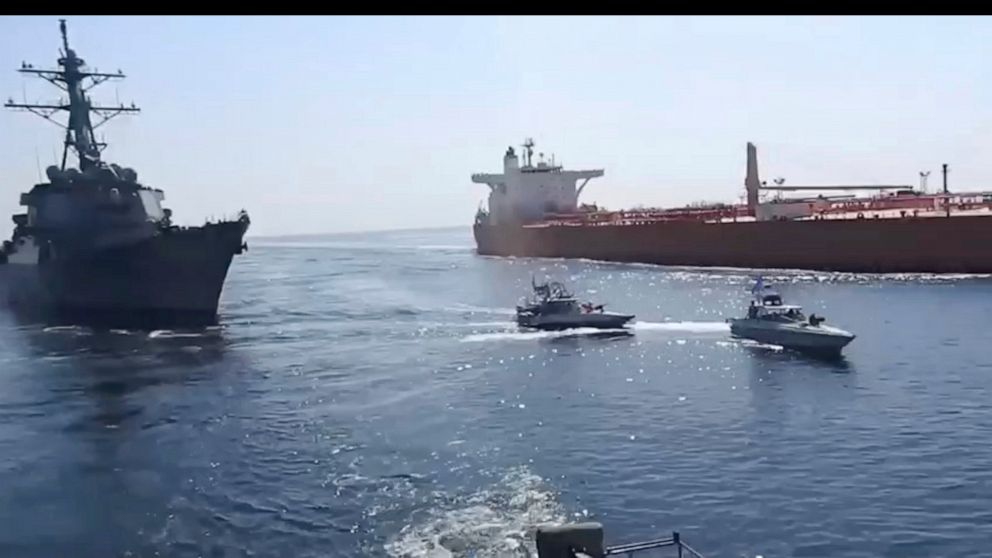Vietnam seeks information from Iran about seized oil tanker
HANOI, Vietnam — Vietnam was seeking more information Thursday about a Vietnamese oil tanker that was seized at gunpoint last month by Iranian soldiers in the Gulf of Oman, while vowing to ensure the safety and humane treatment of the ship’s crew members.
Iran’s powerful paramilitary Revolutionary Guard troops on Oct. 24 took control of the MV Southys, a vessel that analysts suspect of trying to transfer sanctioned Iranian crude oil to Asia. U.S. forces had monitored the seizure but ultimately didn’t take action as the vessel sailed into Iranian waters.
The episode was the latest provocation in Mideast waters as tensions escalate between Iran and the United States over Tehran’s nuclear program.
Vietnamese officials “continue to closely follow the developments and work closely with Iranian authorities to resolve this issue in accordance with the law and enact necessary measures to safeguard the rights and interests of Vietnamese nationals,” Pham Thu Hang, deputy spokesperson in Vietnam’s Ministry of Foreign Affairs, said Thursday.
The captain of the MV Southys told the Vietnamese Embassy in Iran that all 26 crew members were being treated well and were in “normal health,” Hang told reporters at a scheduled briefing.
Iran celebrated its capture of the vessel in dramatic footage aired on state television Wednesday, the day before the 42nd anniversary of the 1979 seizure of the U.S. Embassy in Tehran.
Ship-tracking data analyzed by The Associated Press from MarineTraffic.com showed the vessel still off Iran’s southern port of Bandar Abbas on Tuesday. A satellite photo from Planet Labs Inc. also showed the vessel off Bandar Abbas in recent days.
Iranian state TV offered a series of contradictory reports about a confrontation between the Guard and the U.S. Navy’s Mideast-based 5th Fleet. State TV sought to cast the incident as an act of American aggression against Iran in the Gulf of Oman, with the U.S. Navy detaining a tanker carrying Iranian oil and the Guard freeing it and bringing it back to the Islamic Republic.
Asked about Iran’s assertion of U.S. aggression, Pentagon press secretary John Kirby said it was false and that it was Iran that had seized what he described as a merchant vessel in the Gulf of Oman on Oct. 24.
“It’s a bogus claim,” Kirby said of the Iranian assertion. “The only seizing that was done was by Iran.” He declined to cite the nationality of the vessel that was seized, saying it was up to that country to discuss it.
Kirby said Iran’s boarding and seizing of the vessel “constituted a blatant violation of international law that undermines freedom of navigation and the free flow of commerce.”
Tehran also did not provide the ship’s name, or other details, nor any explanation of why the Navy might target it. Iran’s mission to the United Nations did not immediately respond to a request for comment.
State TV released footage showing an Iranian surveillance drone monitoring a hulking red tanker in the Gulf of Oman. Heavily armed Iranian commandos then rappelled onto the boat from a helicopter as small speedboats surrounded the vessel and an Iranian catamaran ship patrolled the waters.
The video appeared to show Iranian Guard troops pointing uncovered deck-mounted machine guns at the USS The Sullivans, an Arleigh Burke-class guided missile destroyer. Photos released by the U.S. military show The Sullivans recently in the Arabian Sea near the Gulf of Oman.
A shipping database showed the Southys’ last registered owner as OPEC Petrol Transportation Co., a firm with a Hanoi address. On Thursday, a worker at the office acknowledged an incident involving the Southys but referred questions to another employee who wasn’t there. That employee did not immediately return a request for comment.
However, the Southys had been on the radar of United Against a Nuclear Iran, a New York-based advocacy group long suspicious of the Islamic Republic. In a letter dated Oct. 11 addressed to the Vietnam Maritime Administration, the group said its analysis of satellite photos showed the Southys received a ship-to-ship transfer of oil in June from an oil tanker called the Oman Pride.
The U.S. Treasury identified the Oman Pride in August as being used to transport Iranian oil as part of a smuggling scheme to enrich the Guard’s expeditionary Quds Force. That Iranian oil ends up being sold into East Asia, the Treasury alleged, without identifying a specific country.
Iran’s seizure of the Southys would be the latest in a string of hijackings and explosions to roil the Gulf of Oman, which sits near the Strait of Hormuz, the narrow mouth of the Persian Gulf through which a fifth of all traded oil passes.
The U.S. Navy blamed Iran for a series of limpet mine attacks on vessels that damaged tankers in 2019, as well as for a fatal drone attack on an Israeli-linked oil tanker that killed two European crew members earlier this year. Just a few months ago, Iranian hijackers stormed and briefly captured a Panama-flagged asphalt tanker off the United Arab Emirates.
Tehran denies carrying out the attacks, but a wider shadow war between Iran and the West has played out in the region’s volatile waters since then-President Donald Trump withdrew the U.S. from Iran’s nuclear deal in 2018 and imposed crushing sanctions on the country.
———
Associated Press writers Isabel DeBre in Dubai, Amir Vahdat in Tehran, Iran, and Robert Burns and Matthew Lee in Washington contributed to this report.
![]()


